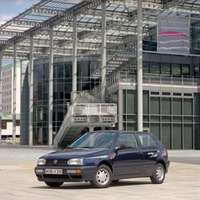Volkswagen: Over Three Decades Of Research For A Zero-Emissions Future
BOTANY, AUSTRALIA – November 11, 2010: In the mid-1970s Volkswagen began to build electric vehicles in the framework of its research activities. And over two decades ago, Volkswagen launched its first model with pure electric drive on the market – the Golf CityStromer. Although it was only built in a small production run, it opened a window to the future as an automotive vision of zero- emissions progress. This vision becomes a reality in 2014, when Volkswagen will launch its first electric cars on the market in large-scale production. Short production run in 1989, mass production in 2014 – these zero-emissions vehicles demonstrate how Volkswagen has been driving the development of this zero-emissions technology for decades now. But it also illustrates how the path to the future cannot be forced, even with the best intentions. Only continual research and continual progress can make the future a reality, and only when the time is ripe for it.
Initial research results in the area of electric drives were obtained in 1976 in a first generation Golf. It was equipped with a 20 kW electric motor. By 1986, this first E-Golf served as a test vehicle in which different battery types and electric motors were tested.
The first Golf CityStromer debuted in 1989
Valuable
experience gained with the test platform flowed into the development of the
Golf CityStromer, which was based on the second generation Golf. In 1989,
it was the first electric vehicle to enter Volkswagen’s regular model
lineup. Thanks to its 18.5 kW AC motor, the Golf CityStromer could
accelerate to 50 km/h in 13 seconds and reach a top speed of 100 km/h.
Sixteen lead-gel batteries installed under the bootspace floor served as energy-storage devices; operating at 96 Volts, they had an energy capacity of 120 Ampere-hours (Ah). This enabled a range of about 50 kilometres. To ensure nearly exclusive use of the stored electrical energy for propulsion, certain auxiliary consumers were supplied with energy from other sources. For example, the heating system in the Golf CityStromer operated with diesel fuel to guarantee comfortable temperatures even in winter. To charge its batteries, the Golf CityStromer was simply connected to a conventional 220-Volt electrical outlet. The pull-out connector cable was located behind an access door in the radiator grille.
Volkswagen launches second Golf CityStromer in 1993
When
Volkswagen presented the third generation of the bestselling Golf in 1991,
intensive development of a new CityStromer had been conducted for some
time. It went into production in 1993, built in a joint venture with
Siemens. A total of 120 CityStromers based on the third generation Golf
were built until 1996.
The first units were initially sold to regional utility companies across Germany. The car’s exterior was practically indistinguishable from conventional Golf series models, and the second Golf CityStromer showed an astonishingly high level of everyday practicality that was excellent for those times and still commands respect today. With technologies such as braking energy recovery (battery regeneration), this Golf set standards for sustainability in the 1990s.
The energy needed to operate the electric motor was stored in 16 maintenance-free lead gel battery blocks with a total energy capacity of 180 Ampere-hours (Ah); the system operated at 96 Volt. The synchronous AC motor with frequency converter achieved an output power of 17.5 kW, and the silently operating propulsion unit accelerated the 1.5 tonne four-door to a top speed of 100 km/h. When driven at a constant 50 km/h – e.g. in urban areas – ranges of up to 90 kilometres were possible. Unlike the vast majority of electric vehicles, the Golf III CityStromer had a four-speed manual gearbox instead of a continuously variable automatic. Any conventional 220-Volt electrical outlet could serve as a “fuelling station” here. It took about one and a half hours to charge the batteries to 80 percent capacity, while complete “fuelling” required a little more time.



